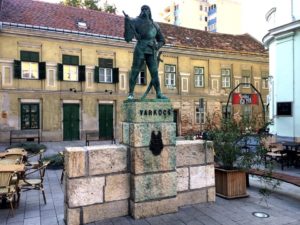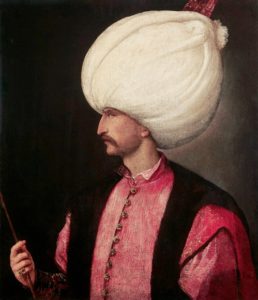Varkocs György, the defender of Székesfehérvár Castle



Varkocs György was another renowned member of the family who died in defending (Székes)Fehérvár Castle, the ancient coronation town of the Hungarian kings. We do not know the details and the circumstances of how Varkocs György took the side of King Ferdinand, it may have been after the death of King Szapolyai in 1540. It is likely that he wanted to get his domains back in this way. However, we can find him in Pest in the autumn of 1540 where he was in command of the German garrison.

They had to hold the city in the spring of the next year when Brother Martinuzzi György sent the Ottoman Turks against them. They fought bravely and could keep the town, though. The main army of the Sultan arrived at the end of the summer, and they managed to take Pest, and Varkocs could only narrowly escape. Another family member, Varkocs Tamás used to be one of the captains of Eger Castle and took part in making the fort’s construction stronger. One of the bastions was named after him.

Buda fell to the enemy in 1541, and it shocked the entire Christendom. They set out to retake it the next year but the Imperial army was beaten at Pest. However, these attacks made Sultan Suleiman realize that Buda and Pest were quite far away from the Dráva river and he would not be able to keep them for long. He had to widen his hinterland to defend Buda effectively. Eventually, it brought along the gradual Ottoman conquest of Hungary’s middle section. Suleiman launched a campaign in 1543 and took Siklós, Pécs, Esztergom, and Tata castles. The siege of Székesfehérvár took place after these conquests, at the end of August.

Ferdinánd appointed Varkocs György as captain of Fehérvár in the first part of 1543 when everybody already knew that Suleiman would arrive in person in Hungary. The king assigned to him several thousand Hungarian, German, Bohemian, Italian, and Spanish troops but not all of them could arrive in Fehérvár in time. We know that Werbőczy Imre, a famous Borderland warrior also served there. When the army of the Sultan arrived there, the garrison had not been filled up yet. In the meantime, the burghers of Székesfehérvár were against the appointment of Varkocs, knowing that he would fight until the last man. It is known that the wealthier burghers had made contact with the Ottomans even before the siege began in 1543.

Even Varkocs was outside the castle at that point. The burghers were negotiating about the surrender of the city when Lord Varkocs arrived on 20 August and officially took over the command. The Ottoman troops were right on his heels because he had returned only a few days before the besiegers totally surrounded the castle. Varkocs tried to strengthen the outer cities as much as he could. He had altogether 1,000-1,200 soldiers, including the burghers and some of the people who took shelter in the city.

The vanguard of the Sultan was all around the city on 20 August but the defenders bravely sallied and attacked them. Before the wall-breaching cannons arrived, the Ottomans tried to take the outer city by an infantry assault but the defenders repelled them, inflicting heavy losses on them.

The siege began in earnest on 28 August with a heavy artillery bombardment. Soon, huge breaches were made on the walls of the outer town, and Pasha Huszrev ordered the general assault but it was duly repelled. Not only the soldiers but the burghers and the refugees from the neighboring area also fought on the walls, along with lots of women. The besiegers had great losses. The next assault on the following day was also beaten back.
In spite of the successful defense, the members of the garrison began to debate against each other, and the burghers wanted to give up the castle. Many of them wanted to pack their things already. The soldiers kept them back with weapons. The Italians and the Spanish mercenaries slaughtered those of their fellow soldiers who were talking about surrender. Then, Suleiman issued an order on 2 September and he allowed the soldiers to take whatever they could put their hands on, and they could keep it as booty. It proved to be very encouraging.

Then, the Ottomans managed to break into the outer city on 2 September under the cover of the fog they took the so-called Budai (later Beslia) Gate. Varkocs and his hussars tried to fend them off but soon they were outnumbered. When they wanted to withdraw into the castle, they were not allowed to get into the inner castle because the burghers closed the gate. The warriors were begging the burghers to let down the drawbridge and let them come in but it was in vain. The burghers said that if they opened the gate, the Turks would certainly push in after the Hungarians. Thus, the Hungarian warriors made their last stand and faced the enemy but they were outnumbered and massacred. Captain Varkocs György fell with them. Suleiman had the severed head of Varkocs carried around in the town for everyone to see.

After Varkocs perished, the burghers started talks with Suleiman. The Italian and German mercenaries did not want to surrender, unlike the burghers. At first, the Sultan promised to let the foreign mercenaries leave but he wanted to punish the Hungarians. Finally, all soldiers could leave under safe conduct and he gave mercy to the Hungarians. When the foreign mercenaries left, they robbed the widow of Varkocs György, taking away all her belongings.

Many of the burghers left Székesfehérvár, and they were the lucky ones because the Sultan had many of the surviving burghers executed, and lots of them were relocated to distant parts of the Ottoman empire. The city got quite depopulated. Soon, southern Slavic inhabitants were settled in Székesfehérvár aka Üsztüni-Belgirád in Turkish. You can read more about the history of Székesfehérvár castle here:
https://www.hungarianottomanwars.com/ottoman-occupied-lands/szekesfehervar/
The heroic deed of Varkocs György and his men were not forgotten, a Latin poem was written to commemorate their sacrifice.

Source: Szibler Gábor
Dear Readers, I can only make this content available through small donations or by selling my books or T-shirts.
If you like my writings, please feel free to support me with a coffee here:
You can check out my books on Amazon or Draft2Digital, they are available in hardcover, paperback, or ebook:
https://www.amazon.com/dp/198020490X
or at https://books2read.com/b/boYd81


My work can also be followed and supported on Patreon:

https://hungarianottomanwars.myspreadshop.com/all

